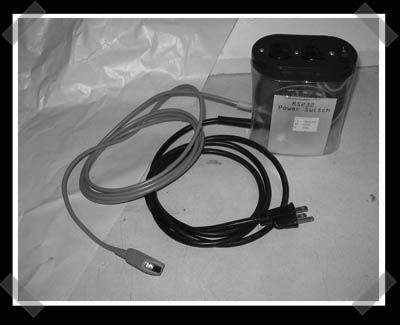
[Alan] sent me his simple rs-232 controlled power outlet. He built it to turn on his laser printer when a print job appeares in the queue. The relay is directly controlled by the DTR line on the serial port. Lots of espresso machine PID conversions use them to run boilers, so he could have avoided the extra mechanical relay. [I can’t pick on him too much, my old laserwriter is on all the time.]
He tied it together with some perl to turn on the printer and get the print job going once it’s had enough time to initialize.















“But I have more fun breaking, I mean making things myself, “
I have a lot experience breaking things, making them work is th trick :-)
cool, ive been looking to do something like this, but ive been too lazy
And for the rest of us, there’s the printer’s sleep mode. Not as effective, but still retains the warranty.
Also, I suppose this could be combined with the Wake-on-lan hack from a few days ago, to get a sort of WOL relay for your network printer.
I also made a similar power outlet, based on DPMS:
http://www.ccs.neu.edu/home/bchafy/pstrip/dpmspowerstrip.html
Here’s another that uses the parallel port (found it on digg), albeit a little on the dangerous side: :)
http://www.foogazi.com/2006/11/03/controlling-electronic-devices-made-easy/
My guess is any one of these could be combined with wake-on-lan. Problem for me is I have an inkjet printer that goes into a 10+ minute selftest whenever its unplugged and plugged back in. I suspect most of my cartrige ink drains away during that time. Fortunately it doesn’t consume much power.
oooh…a Laserwriter. What model?
uhhh yeah, about that foogazi.com link… there are many things wrong with that circuit. first, it’s got the paralell port directly running a relay. besides the fact that there is no mention of a protection diode (!!) virtually any relay will pull more current than what your typical parallel port is rated for. an npn transistor and resistor is absolutely essential. furthermore, he’s got the whole thing with AC mains wiring in a cardboard box! i wouldnt even think about doing that!
bchafy: just took a look at your dpms circuit. nice :)
Neat. Could also automagically power cycle the cable modem if it loses sync (they usually give up re-trying after 15 minutes).
Although, for the non-DIY’er who has more money than time there is X10:
First you need the controller:
http://www.smarthome.com/1132b.html
Then your need plugin modules:
http://www.smarthome.com/2456s3.html
And naturally software to drive it:
http://www.linuxha.com/
That scares the holy shit outta me. He needs a light bridge to provide 100% isolation from the serial port to the switching device. Of course, you’ll need an extra board for the AC main turn on/off switch.
And do it in a plastic Radioshack project box, with proper safety (erm, like fuses???).
Hello I wrote the article http://www.foogazi.com/2006/11/03/controlling-electronic-devices-made-easy/ and in response to the person who says it’s dangerous… It is dangerous if youre paranoid. But in general it’s fine. If buy the exact relay i put there your parallel port will be fine. If you buy a different and connect it directly it might burn out your parallel port so yeah you will want to add a didoe.I tried to make it as easy as possible. And ac with the cardboard… The only way it would even start a fire is if the two wires some how touch. very unlikely.. Especailly beacuse mine are all insulated
> It is dangerous if youre paranoid. But in general
> it’s fine. If buy the exact relay i put there your
> parallel port will be fine
You mean the solid state relay rated at 1-AMP ?
Just call me paranoid then :)
> And for the rest of us, there’s the printer’s sleep
> mode. Not as effective, but still retains the
> warranty.
My hack here retains the printer warranty also. The printer is just on a glorified power strip. Of course, any printer new enough to have a warranty probably also has a decent sleep mode.
> That scares the holy shit outta me. He needs a light
> bridge to provide 100% isolation from the serial port
> to the switching device.
I was under the impression that solid state relays include an opto-isolator in them. I don’t really know. That’s a good point to investigate.
> oooh…a Laserwriter. What model?
This is a LaserWriter Pro 630. It can do PostScript and PCL 2, with serial AppleTalk, 10Mbps EtherTalk, and Centronics parallel interfaces. The PCL is limited to 300×300 resolution, while the PostScript can do 600×600 resolution. And the parallel port is glacially slow. So I drive it with PostScript over the EtherTalk interface.